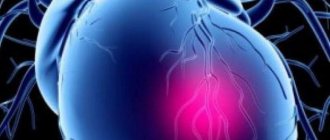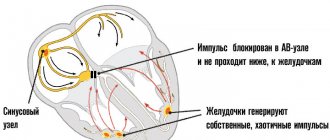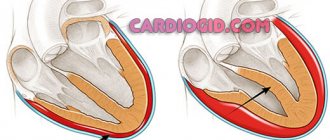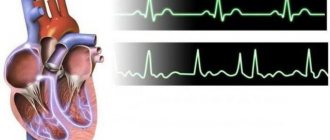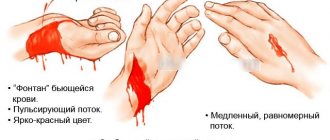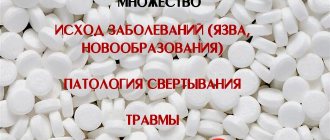Gastric bleeding is the leakage of blood into the lumen of the stomach from damaged vessels. This pathological condition occupies a leading position among all causes of emergency hospitalization in surgical hospitals.
Source: cardio-life.ru
More than a hundred pathologies are known that can lead to the development of gastric bleeding. The most common of these is gastric ulcer - bleeding occurs in approximately 20% of patients with a history of gastric ulcer in the absence of adequate treatment.
In case of heavy gastric bleeding, hospitalization in the intensive care unit is required.
The stomach is a hollow muscular organ located between the esophagus and the duodenum. The function of the stomach is the accumulation of food mass, its mechanical and chemical processing, absorption of certain substances, and movement further along the digestive tract. In addition, the stomach produces hormones and biologically active substances and performs protective and excretory functions. The volume of an empty stomach is approximately 0.5 liters; after eating, the stomach can stretch to 1–4 liters. The size of the organ varies depending on the degree of its filling, as well as on the person’s body type. The wall of the stomach is formed by serous, muscular, submucosal and mucous membranes. The stomach consists of the inlet section, the fundus of the stomach, the body of the stomach, and the pylorus. The venous plexus is located at the junction of the esophagus and the stomach. In some pathological processes, veins dilate and are easily injured, which causes bleeding, sometimes quite significant.
Classification of bleeding
Gastric bleeding (according to ICD-10 its code is K92.2) is a very dangerous condition that, if not treated in a timely manner, can lead to death.
By etiology:
- Ulcerative (for peptic ulcer of the stomach and duodenum).
- Non-ulcerative, arising for other reasons.
By duration of bleeding:
- Acute - rapid, fairly pronounced bleeding over a short period of time.
- Chronic - long-term, less intense.
Depending on the severity of the symptoms, gastric bleeding can be:
- Explicit. If they are present, we can undoubtedly talk about hemorrhage; making a diagnosis is not difficult.
- Hidden. There are no obvious symptoms; other diagnostic tests are required to determine the cause of pale skin.
Emergency care for stomach bleeding will be described below.
First aid
Activities that help stop bleeding can be done at home.
Emergency aid algorithm:
- The patient is ensured the correct position of the body. He is placed on his back. The legs are raised at an angle of 15˚.
- They are not allowed to eat or drink.
- Ice is applied to the abdominal area. It causes vasoconstriction and reduces blood flow. The procedure takes 15 minutes. Take a 5-minute break. The manipulation is repeated.
- The patient is given a Dicinone tablet. It is pre-crushed.
Injections of Papaverine and Atropine are given in case of acute bleeding.
The windows in the room are opened for normal circulation of fresh air. It is forbidden to wash the intestines. Clears the airways of blood, vomit, and mucus. Ammonia is used if the patient loses consciousness.
First aid will help prevent unwanted, dangerous consequences.
Causes
The causes affecting changes in the stomach are listed below:
- Peptic ulcer disease. In more than 20% of cases, this pathology tends to be complicated by bleeding and occurs due to the aggressive influence of gastric juice.
- Vascular thrombosis, therefore, increases pressure, which leads to thinning of the wall and effusion of contents into the organ cavity.
- Malignant neoplasms. Cancer in this case occurs either primarily (that is, there are no pathological processes predisposing to its development) or is a complication, for example, of the same peptic ulcer. First aid for gastric bleeding should be provided in a timely manner.
- Diverticulum is the presence of a protrusion of the wall or all its layers. This will be a true diverticulum. Or without involving any layer - false. Diagnosis is not difficult: when examining the x-ray picture, the “finger” symptom is visible.
- Diaphragmatic hernia, in which the stomach passes through the existing physiological opening in the diaphragm, connecting the thoracic and abdominal spaces. This is observed in the following pathologies: ulceration of the mucous membrane under the influence of aggressive gastric juice and when combined with ulcerative lesions.
- Polyps are a type of benign tumor. The cause of bleeding, if present, is injury from the active components of gastric juice and disruption of the “nutrition” of the polyp, for example, when the leg is pinched or twisted. Treatment for stomach bleeding will largely depend on the cause of its occurrence.
- Mallory-Weiss syndrome. Occurs when a crack forms in the area where the esophageal mucosa transitions to the gastric mucosa. This can be triggered by drinking alcoholic beverages in combination with large amounts of food or if the patient already has a diaphragmatic hernia.
- Hemorrhagic gastritis. With this type of gastritis, ulcerative changes appear on the surface of the upper wall, initially presented in the form of erosions, with the possibility of developing into huge (more than 3 centimeters) ulcers.
- Stress ulcers. They arise from any severe stress, during which the protective reaction of our body becomes “decompensated”, resulting in a sharp release of adrenal hormones. This leads to increased acidity of the juice and, accordingly, the formation of surface defects such as erosions or ulcers. What other causes of stomach bleeding are there?
Vascular disease can lead to bleeding. Varicose veins of the venous plexus of the lower esophagus and upper part of the stomach are observed with:
- liver cirrhosis;
- neoplasms;
- portal vein thrombosis, compression of various etiologies;
- chronic lymphocytic leukemia.
Systemic vasculitis, such as periarteritis nodosa and Henoch-Schönlein purpura, is dangerous. These are autoimmune diseases that damage the walls of blood vessels.
Atherosclerosis and hypertension can also cause bleeding in the stomach. With this category of pathology, there is a possible risk in the form of overstrain of the vascular wall and subsequent rupture, accompanied by gastric bleeding.
A bleeding disorder causes a dangerous condition in the stomach:
- Hemophilia - reduced blood clotting. This is a hereditary disease.
- Leukemia is acute and chronic, in particular when platelet formation is impaired.
- Hemorrhagic diathesis. They combine disorders of both blood clotting and increased bleeding.
- Lack of vitamin K. Leads to hemorrhages in various groups of organs, including vital ones, such as the brain.
Prevention
Internal bleeding of the gastrointestinal tract (symptoms should be a cause for concern) can be prevented. Compliance with preventive measures will not completely eliminate the risk of developing pathology, but will significantly reduce it.
The first and most important is the normalization of the diet, as well as menu correction. It is important to exclude smoked foods, very sour and spicy dishes. This will reduce the negative impact on the mucous membranes. Additionally, you should avoid carbonated drinks, strong tea and coffee, and reduce the amount of alcohol consumed to a minimum.
Patients who have been smoking for many years should give up this habit. It is important to avoid stressful situations and not take too long breaks between meals. In addition, you should not take medications without a doctor’s prescription, and also increase the dosage and duration of the course.
Patients with chronic pathologies of the digestive tract should regularly visit a doctor and undergo a course of treatment to prevent complications.
Signs of stomach bleeding
General symptoms:
- Feeling of weakness, lethargy.
- Paleness of the skin and visible mucous membranes.
- Cold sweat.
- Decrease in blood pressure value.
- Frequent weak pulse fluctuations.
- Dizziness and feeling of fullness in the ears.
- Manifestations of lethargy, confusion, even loss of consciousness.
Accordingly, the more massive the blood loss, the faster and more clearly the clinical picture appears. If in the current situation first aid for gastric bleeding was not performed, then the risk of death is very high.
A distinctive feature is the nature of the vomit, which resembles “coffee grounds” in color.
Coloring in this color is achieved by exposure to hydrochloric acid. If the blood in the vomit has an unchanged color, then we can assume that this is bleeding from the upper parts (for example, the esophagus) or massive bleeding, in which the blood simply does not have time to interact with the acid.
A specific symptom is also the presence of black, tarry stools - melena.
Diagnostics
Internal bleeding of the gastrointestinal tract (symptoms can significantly worsen the patient's condition) is not so difficult to diagnose if it occurs in an acute form. However, the doctor uses several methods that help clarify the diagnosis.
| Method | Features of the event | Venue and cost |
| General examination and questioning of the patient | The first and most important stage of diagnosis. The doctor examines the patient, palpates the abdomen, and also assesses the condition of the skin, measures blood pressure and counts the pulse. In addition, it is important to interview the patient, determine the probable cause of the disorder, as well as the time and conditions for the onset of symptoms. | Carried out in every medical institution free of charge |
| Clinical blood test | A general blood test is considered an important point in diagnosis. Blood is taken from a finger or vein and then examined in a laboratory. The result usually shows a decrease in hemoglobin of varying severity, as well as an increase in the erythrocyte sedimentation rate and a slight increase in the level of white blood cells if the bleeding is accompanied by an inflammatory process | The method is available for use in any clinic; the price in a private institution is approximately 200 rubles. |
| Blood chemistry | In a biochemical study, a coagulogram plays an important role, which helps to assess the patient’s condition. Blood is taken from a vein, and the diagnostic result allows you to clarify the degree of neglect of the condition | It is carried out in government institutions; in private institutions the price is approximately 200-250 rubles. |
| Examination of feces and vomit | An additional and effective diagnostic method in which the patient's stool and vomit are examined in a laboratory setting to identify pathogenic microorganisms | Carried out free of charge in public clinics |
| X-ray of the stomach and esophagus | One of the most effective methods in which X-rays can be used to see areas of blood accumulation in the digestive tract | It is carried out in state medical institutions, the price is approximately 200-300 rubles. |
| Magnetic resonance angiography of the vessels of the digestive tract | The most effective and informative method, in which, using special equipment, you can see which vessel in the digestive tract is damaged | It is carried out only in clinics where the appropriate equipment is available, the price is approximately 2000 rubles. |
The use of several effective methods allows not only to clarify the diagnosis, but also to determine the degree of neglect of the disease, as well as prescribe the correct treatment.
Severity
- Mild - minor blood loss. The patient's condition is satisfactory, the pulse is not higher than 80 beats per minute, and the systolic blood pressure does not fall below 110 mm. rt. Art. The patient is conscious.
- Average degree - increased heart rate to 90-100 beats per minute, decreased blood pressure to 100-110 mm. rt. Art. The skin and mucous membranes are pale, covered with sticky cold sweat, the patient experiences severe dizziness.
- Severe degree - severe inhibition, and in some cases, unconsciousness with a lack of response to strong stimuli. The pulse is more often than 110 beats, the blood pressure, accordingly, is significantly less than 110 mm. rt. Art.
Why does bleeding occur in the gastrointestinal tract in children?
Internal bleeding in children is a fairly rare occurrence. The reasons for the development of pathology in this case differ significantly from adults. Blood loss can be caused by:
- hemorrhagic disease. Typical for newborns. Occurs against the background of vitamin K deficiency;
- infectious diseases. Most often observed in children aged one to three years;
- worm infection. Possible in children of any age. However, children of kindergarten and primary school age are most often affected;
- trauma to the gastrointestinal mucosa. For example, as a result of a blow or accidental ingestion of a foreign object.
Emergency care for stomach bleeding
What is emergency treatment for bleeding from the stomach? All necessary steps are listed below:
- Providing bed rest, which helps reduce the rate of bleeding.
- Applying a cold compress (we will consider the algorithm below).
- Washing the stomach with ice water, the essence is to spasm the bleeding vessels and subsequently stop or slow down the blood flow.
- Prescription of adrenaline or norepinephrine drugs through a gastric tube. This group of hormones belongs to stress factors that cause compensatory narrowing of the lumen of blood vessels.
- Replenishment of total circulating blood volume (TBV) by administering hemostatic solutions intravenously.
- Use of donor blood, blood substitutes and frozen plasma as a replacement for lost blood.
Other therapy is carried out if indicated.
Treatment
The choice of tactics depends on the cause of bleeding. Treatment is not carried out at home. A specialist knows how to stop intestinal bleeding and provide adequate therapy.
Hemostatic measures are carried out using instrumental methods. They include:
- Clipping.
- Ligation.
- Surgery.
Therapeutic measures are carried out using drugs such as:
- Aminocaproic acid.
- Hemostatic drugs Fibrinogen, Etamzilat.
- Reopoliglyukin.
- Erythrocyte mass.
- Frozen blood plasma.
- Calcium chloride.
- Vitamin K
- Medicines that restore the volume of intercellular fluid.
The choice of specific minimally invasive treatment depends on the clinical picture:
- Coagulation of damaged vessels using an endoscope is used for frequently recurring hemorrhages.
- Vessel ligation and sclerotherapy are used in cases of injury to varicose veins of the esophagus.
- A colonoscopic electrocoagulator is used for severe, prolonged bleeding from the lower segments of the digestive tube.
For moderate blood loss, the main goal of therapy is to eliminate the underlying cause.
Bleeding from the colon, which occurs against the background of complicated diverticular disease, is eliminated by infusion of Vasopressin. This is done using a catheter, which is not removed for 48 hours, since the complication recurs.
Necrosis of the intestinal wall, local or diffuse peritonitis requires emergency surgical assistance. This involves resection of the affected part of the intestine .
Hemorrhoidal damage to the organ is treated with sclerosis and bandaging.
If signs of bleeding do not stop or intensify, the patient undergoes an autopsy of the abdominal cavity. Surgery allows you to detect the source of bleeding. Subsequent treatment is carried out according to the examination.
Cold compress
A trusting relationship must be established with the patient. He needs to understand the purpose and process of applying a cold compress. The algorithm of actions performed with his consent is as follows:
- Hands must be washed and dried.
- Prepare all the necessary items (gauze pads, a bowl of water, ice).
- One of the napkins is moistened in cold water and lightly wrung out.
- Apply to the desired area of the body.
- The compress is changed every two minutes, at which time a second napkin is applied.
Indications for surgical treatment
Acute gastric bleeding is an indication for surgery for:
- lack of positive results from previously performed conservative and endoscopic measures;
- the patient’s condition is unstable or serious, which may become more complicated in the near future (for example, coronary artery disease or stroke);
- repeated bleeding.
In adults
Stomach bleeding in adults can be the most dangerous. Especially in old age. In some cases it can be fatal. In young and middle-aged people, with adequate therapy, the process can result in recovery.
People over sixty years of age are at risk for deaths. This is due to impaired hemostasis. In old age, the functions of internal organs are also weakened.
Elderly people with various health conditions are especially at risk. It could be a trivial arrhythmia and hypertension. Which is a common occurrence in this category of patients. The risk group includes people with the following disorders:
- bradycardia;
- tachycardia;
- hypotension;
- chronic kidney failure;
- cardiovascular pathology
Acute and chronic manifestations of gastric bleeding occur among the adult population. Acute bleeding is manifested by a number of signs. Chronic bleeding can be hidden.
With obvious bleeding, diagnosis is greatly facilitated. However, there are signs of obvious bleeding on the face. The most common signs:
- bloody vomiting;
- anemia
With chronic bleeding, diagnosis becomes more complicated. That is, one can only suspect this pathology. It is advisable to conduct a clinical diagnosis. Namely, a stool test for occult blood.
go to top
Rehabilitation measures after surgery
It is important to follow all the doctor’s recommendations, then recovery will come faster.
- Day one - you can move your arms and legs.
- Day two - the beginning of the introduction of breathing exercises.
- Day three - you can try to get back on your feet.
- Day eight - postoperative sutures are removed.
- Day fourteen - discharge from the department with recommendations to limit physical activity for a month and the need to perform a set of physical therapy exercises.
Diet after surgery
The following rules apply to diet:
- Day one - you can’t drink or eat, just dry the surface of your lips.
- Day two - you are allowed to drink half a glass of water with a teaspoon.
- Day three - it is possible to increase the amount of liquid consumed (water, broth, juice) to half a liter.
- Day four - up to four glasses of liquid are allowed, taking into account the division of this amount into 8-12 doses. You can eat slimy soups.
Starting from the fifth day, cottage cheese and semolina porridge are added to the diet, and from the seventh - boiled meat. The transition to regular meals in small portions is allowed from the ninth day.
So, we looked at emergency care for gastric bleeding.
Exodus
Stomach bleeding can end unfavorably. The patient may fall into a comatose state. And this is directly related to the intensity of bleeding and the timeliness of treatment.
Only with timely treatment are positive trends observed. Until recovery. If the patient begins treatment on time, the outcome is favorable. Especially with surgery followed by symptomatic therapy.
An unfavorable outcome is associated with the occurrence of various complications. With hemorrhagic shock or coma. Which undoubtedly leads to mortality among patients.
go to top
